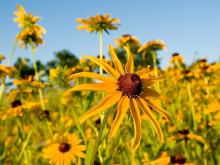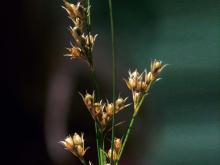Wildflowers, Grasses and Other Nonwoody Plants
Media

Species Types
Scientific Name
Rudbeckia triloba
Description
Brown-eyed Susan is a bushy perennial with much-branching stems and plenty of flowerheads. Compared to Missouri’s other Rudbeckia species, its flowerheads are the smallest, growing to only about one inch across.
Media

Species Types
Scientific Name
Rudbeckia hirta
Description
Black-eyed Susan is a tremendously popular native wildflower for gardening. It’s also commonly planted along roadways, so when it’s blooming, May through October, you’re sure to see it somewhere.
Media

Species Types
Scientific Name
Juncus spp. and Luzula spp.
Description
Missouri has 24 species in the rush family. Distinguishing between these grasslike plants can be tricky, but it’s easy to learn some basics about the group.
Media

Species Types
Scientific Name
Carex, Schoenoplectus, Scirpus, and other genera
Description
Missouri has more than 200 species in the sedge family. Distinguishing between these grasslike plants can be difficult, but it’s easy to learn some basics about the group.
Media

Species Types
Scientific Name
Helianthus spp.
Description
Most people recognize sunflowers when they see them, with their bright yellow ray flowers and rather flattened center of dark disk flowers. There are 16 species of Helianthus in Missouri.
Media

Species Types
Scientific Name
Scrophularia marilandica
Description
Eastern figwort occurs statewide in rich woods, woodland borders, and bottomlands. It’s usually 2-5 feet high, has square stems and lance-shaped, toothed leaves, and bears spreading clusters of small, green scoop-shaped flowers with brown petal lobes.
Media

Species Types
Scientific Name
Rumex crispus
Description
Curly dock’s rosettes of wavy-edged, leathery leaves are a common sight on roadsides and other disturbed lands. The fruit clusters at the top half of the plant turn dark rusty brown and are easy to spot from a distance.
Media

Species Types
Scientific Name
Hexalectris spicata (syn. Bletia spicata)
Description
Crested coral root is an orchid that lacks chlorophyll, so none of it is green. It obtains nutrients from fungi and decaying organic matter. Compared to our other coral roots, it is taller and has larger flowers. It grows in Ozark habitats.
Media

Species Types
Scientific Name
Corallorhiza wisteriana
Description
Spring coral root blooms in April and May. Except for a few small sheathing bracts along the stem, it has no leaves. The purplish or brownish flowers are in a raceme at the tip of the stem. Each flower’s lower lip is white with purple markings.
See Also
About Wildflowers, Grasses and Other Nonwoody Plants in Missouri
A very simple way of thinking about the green world is to divide the vascular plants into two groups: woody and nonwoody (or herbaceous). But this is an artificial division; many plant families include some species that are woody and some that are not. The diversity of nonwoody vascular plants is staggering! Think of all the ferns, grasses, sedges, lilies, peas, sunflowers, nightshades, milkweeds, mustards, mints, and mallows — weeds and wildflowers — and many more!





















